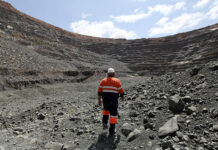
[miningmx.com] – TERENCE Goodlace, who turned 55 this year, took over the leadership of Impala Platinum in July 2012 only months before the chastening events at Lonmin’s Marikana mine in which 34 miners, protesting over pay, were shot dead in one day.
On a scale of 1 to 10, where 10 is you’d have to be stark raving mad to take the CEO job at Impala .. How difficult has Impala been to run in the 18 months or so you’ve been at it?
8. In many ways the past 18 months can best be described as a perfect storm – a labour tsunami, frosty global economy/market, above ground stocks, policy uncertainty and no clarity as to whether the lights could go out at short notice.
The changes wrought by AMCU in the labour movement were bubbling under long before you arrived at Impala. Now you’re the CEO, do you think AMCU related unrest will be a permanent feature of the platinum sector?
No I don’t. I am of the view that we are witnessing a much broader socio-economic shift in our country and this shift clearly extends beyond the platinum industry and/or AMCU.
We have to acknowledge that our young democracy has not yet delivered a better life for all and many legacy issues remain unresolved in our country/industry.
But, I am confident that we are at our best as a country/industry when faced with a set of circumstances that seem impossible to resolve, and we will find the answers we are looking for. It saddens me that it has come with so much intolerance, violence and destruction.
In a nutshell, the problem with the platinum price is the zealous enthusiasm of producers wouldn’t you say, rather than the demand side?
It is definitely much more complex. The market is defined by buyers and a sellers, and in our case, on the supply side there will always be an element of supply push, largely informed by the high fixed cost component in our industry.
There has also been structural shifts in supply, largely informed by the changing minerals legislation that has opened the PGM industry to many new entrants, and with finance freely available in the so called super cycle, has driven supply to overshoot demand.
Critically, on the demand side, we have seen the emergence of recycling as a major new source of supply, we have also seen a switch from platinum to palladium in auto-catalyst use, largely incentivised by the sale of historical Russian palladium stockpiles.
All of this has impacted a relatively precarious global supply/demand dynamic in a relatively small commodity market.
South Africa’s platinum producers keep telling us of the need for production discipline. Yet all we keep seeing are plans for fresh production that (this time) will be low cost. Who’s kidding who? The platinum sector has learned nothing.?
While the market will always be the final determinant of production levels, cost will always be critical in a commodity where you are essentially a price taker.
But as you rightly point out, our future sustainability is clearly determined by much more than just lower costs.
Our plans have to also prioritise the safety, health and welfare of our people, improve our production efficiency/productivity, deliver fair rewards/returns, and incentivise new and expanded use of our products so that our country and society can benefit much more holistically.
One must also be careful to distinguish between replacement ounces and “fresh’ ounces.
If you weren’t head of Impala, what would you be rather doing?
Definitely travelling or heading-up another mining company with equally exciting challenges and products that have a positive impact on the world we live in.
Your career is interesting in that you’ve worked your way up from mine to boardroom. Does that give you any special perspective not afforded to the accountants in braces who ran mining companies in the past?
I would say that it provides a strong calibrated sense of what happens on operations. There are generally a few scars, but also a deep appreciation for what it takes at the rock-face to make these businesses work.
What’s the hardest part of your job?
Definitely the deep sense of loss when someone gets hurt at work.
Ever felt like throwing in the towel? If so, when?
No, not really. Too many people depend on your leadership when things get tough, and we demand resilience from our people every day in harsh and difficult conditions.
The end of a long, hazardous week deserves a) hot curry and a lager, b) seared salmon and fine wine c) canapes and expensive single-malt whisky d) 30 minutes of bench-pressing followed by a cold shower?
Definitely a Caesar Salad and a skinny decaf Cappuccino, or a long cycle ride when my aging body allows.
With whom would you rather be stuck in snow drift: mining journalists or investment analysts?
Possibly the investment analyst, at least most of what is said is not tweeted or ends up in the press.
Goodlace worked up through the ranks at Gold Fields over a 27-year period, starting in 1980 as a learner miner at Evander Gold. He was, at various times, a mine manager at Oryx gold mine and GM at Kinross, before moving into head office where he was appointed Vice-President of Strategic Planning at Gold Fields.
Before becoming CEO of Impala Platinum, Goodlace first headed the South African operations at the gold company and then, on leaving in 2009, joined Metorex where he was the company’s CEO.










